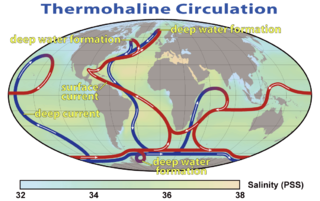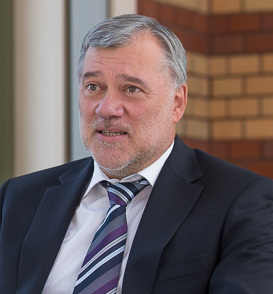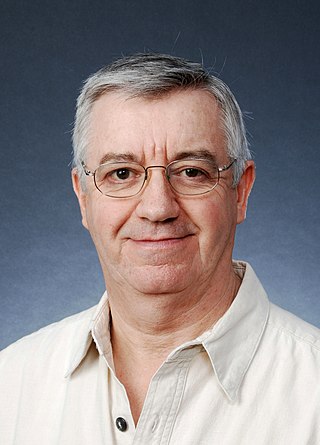Related Research Articles

In chaos theory, the butterfly effect is the sensitive dependence on initial conditions in which a small change in one state of a deterministic nonlinear system can result in large differences in a later state.

Chaos theory is an interdisciplinary area of scientific study and branch of mathematics focused on underlying patterns and deterministic laws of dynamical systems that are highly sensitive to initial conditions, and were once thought to have completely random states of disorder and irregularities. Chaos theory states that within the apparent randomness of chaotic complex systems, there are underlying patterns, interconnection, constant feedback loops, repetition, self-similarity, fractals, and self-organization. The butterfly effect, an underlying principle of chaos, describes how a small change in one state of a deterministic nonlinear system can result in large differences in a later state. A metaphor for this behavior is that a butterfly flapping its wings in Texas can cause a tornado in Brazil.
A complex system is a system composed of many components which may interact with each other. Examples of complex systems are Earth's global climate, organisms, the human brain, infrastructure such as power grid, transportation or communication systems, complex software and electronic systems, social and economic organizations, an ecosystem, a living cell, and ultimately the entire universe.

Oceanography, also known as oceanology, sea science and ocean science, is the scientific study of the oceans. It is an Earth science, which covers a wide range of topics, including ecosystem dynamics; ocean currents, waves, and geophysical fluid dynamics; plate tectonics and seabed geology; and fluxes of various chemical substances and physical properties within the ocean and across its boundaries. These diverse topics reflect multiple disciplines that oceanographers utilize to glean further knowledge of the world ocean, including astronomy, biology, chemistry, climatology, geography, geology, hydrology, meteorology and physics. Paleoceanography studies the history of the oceans in the geologic past. An oceanographer is a person who studies many matters concerned with oceans, including marine geology, physics, chemistry and biology.
Predictability is the degree to which a correct prediction or forecast of a system's state can be made, either qualitatively or quantitatively.

Ian Nicholas Stewart is a British mathematician and a popular-science and science-fiction writer. He is Emeritus Professor of Mathematics at the University of Warwick, England.

Robert McCredie May, Baron May of Oxford, HonFAIB was an Australian scientist who was Chief Scientific Adviser to the UK Government, President of the Royal Society, and a professor at the University of Sydney and Princeton University. He held joint professorships at the University of Oxford and Imperial College London. He was also a crossbench member of the House of Lords from 2001 until his retirement in 2017.

In the study of dynamical systems, a delay embedding theorem gives the conditions under which a chaotic dynamical system can be reconstructed from a sequence of observations of the state of that system. The reconstruction preserves the properties of the dynamical system that do not change under smooth coordinate changes, but it does not preserve the geometric shape of structures in phase space.

Mitchell Jay Feigenbaum was an American mathematical physicist whose pioneering studies in chaos theory led to the discovery of the Feigenbaum constants.

J. Doyne Farmer is an American complex systems scientist and entrepreneur with interests in chaos theory, complexity and econophysics. He is Baillie Gifford Professor of Mathematics at Oxford University, where he is also Director of the Complexity Economics programme at the Institute for New Economic Thinking at the Oxford Martin School. Additionally he is an external professor at the Santa Fe Institute. His current research is on complexity economics, focusing on systemic risk in financial markets and technological progress. During his career he has made important contributions to complex systems, chaos, artificial life, theoretical biology, time series forecasting and econophysics. He co-founded Prediction Company, one of the first companies to do fully automated quantitative trading. While a graduate student he led a group that called itself Eudaemonic Enterprises and built the first wearable digital computer, which was used to beat the game of roulette.
Mark A. Cane is an American climate scientist. He obtained his PhD at MIT in 1975. He is currently the G. Unger Vetlesen Professor of Earth and Climate Sciences at Columbia University and the Lamont Doherty Earth Observatory. He actively pursues several research and teaching initiatives, and supports the Columbia climate kids corner. As of November 11, 2015, his publications have been cited over 22,600 times, and he has an h-index of 75.

Walter Heinrich Munk was an American physical oceanographer. He was one of the first scientists to bring statistical methods to the analysis of oceanographic data. His work won awards including the National Medal of Science, the Kyoto Prize, and induction to the French Legion of Honour.

Jerome Namias was an American meteorologist, whose research included El Niño.

Sallie Watson "Penny" Chisholm is an American biological oceanographer at the Massachusetts Institute of Technology. She is an expert in the ecology and evolution of ocean microbes. Her research focuses particularly on the most abundant marine phytoplankton, Prochlorococcus, that she discovered in the 1980s with Rob Olson and other collaborators. She has a TED talk about their discovery and importance called "The tiny creature that secretly powers the planet".

Jürgen Kurths is a German physicist and mathematician. He is senior advisor in the research department Complexity Sciences of the Potsdam Institute for Climate Impact Research, a Professor of Nonlinear Dynamics at the Institute of Physics at the Humboldt University, Berlin, and a 6th-century chair for Complex Systems Biology at the Institute for Complex Systems and Mathematical Biology at Kings College, Aberdeen University (UK). His research is mainly concerned with nonlinear physics and complex systems sciences and their applications to challenging problems in Earth system, physiology, systems biology and engineering.
Helen Amanda Fricker is a glaciologist and professor at Scripps Institution of Oceanography at the University of California, San Diego where she is a director of the Scripps Polar Center. She won the 2010 Martha T. Muse Prize for Science and Policy in Antarctica.
Michael Ghil is an American and European mathematician and physicist, focusing on the climate sciences and their interdisciplinary aspects. He is a founder of theoretical climate dynamics, as well as of advanced data assimilation methodology. He has systematically applied dynamical systems theory to planetary-scale flows, both atmospheric and oceanic. Ghil has used these methods to proceed from simple flows with high temporal regularity and spatial symmetry to the observed flows, with their complex behavior in space and time. His studies of climate variability on many time scales have used a full hierarchy of models, from the simplest ‘toy’ models all the way to atmospheric, oceanic and coupled general circulation models. Recently, Ghil has also worked on modeling and data analysis in population dynamics, macroeconomics, and the climate–economy–biosphere system.

Trevor Charles Platt was a British and Canadian biological oceanographer who was distinguished for his fundamental contributions to quantifying primary production by phytoplankton at various scales of space and time in the ocean.
Empirical dynamic modeling (EDM) is a framework for analysis and prediction of nonlinear dynamical systems. Applications include population dynamics, ecosystem service, medicine, neuroscience, dynamical systems, geophysics, and human-computer interaction. EDM was originally developed by Robert May and George Sugihara. It can be considered a methodology for data modeling, predictive analytics, dynamical system analysis, machine learning and time series analysis.
Jennifer Ann Mackinnon is an American physical oceanographer who has studied small-scale dynamical processes in oceans for more than 20 years. These processes include internal waves and ocean mixing, turbulence, sub-mesoscale instabilities, and their complex interaction. She is a professor at the Scripps Institution of Oceanography (SIO) of the University of California, San Diego (UCSD). Her research requires some fieldwork at sea to observe these processes.
References
- ↑ "UC Announcement of McQuown Chair". Archived from the original on 2009-01-12. Retrieved 2008-11-22.
- ↑ Sugihara, G.; May, R. M. (1990). "Nonlinear forecasting as a way of distinguishing chaos from measurement error in time series". Nature. 344 (6268): 734–741. Bibcode:1990Natur.344..734S. doi:10.1038/344734a0. PMID 2330029. S2CID 4370167.
- ↑ Sugihara, G., and H. Ye. Cooperative Network Dynamics. Nature458, 979-980
- ↑ Scheffer, M; Bascompte, J; Brock, WA; Brovkin, V; Carpenter, S R; Dakos, V; Held, H; Rietkerk, M; Sugihara, G; et al. (2009). "Early-warning signals for critical transitions". Nature. 461 (7260): 53–59. Bibcode:2009Natur.461...53S. doi:10.1038/nature08227. PMID 19727193. S2CID 4001553.
- ↑ "Scripps McQuown Chair appointment biodata". Archived from the original on 2009-01-12. Retrieved 2008-11-22.
- ↑ Dalton, Rex (2005). "Conservation policy: Fishy futures". Nature. 437 (7058): 473–474. Bibcode:2005Natur.437..473D. doi: 10.1038/437473a . PMID 16177759.
- ↑ Sugihara, G. 2006. Observations on new directions for understanding systemic risk in the financial sector. Federal Reserve Bank of New York and the National Academy of Science.
- ↑ May, R.M.; Levin, S.A.; Sugihara, G. (2008). "Complex systems: Ecology for bankers". Nature. 451 (7181): 893–895. Bibcode:2008Natur.451..893M. doi: 10.1038/451893a . PMID 18288170.
- ↑ Biodata at Scripps